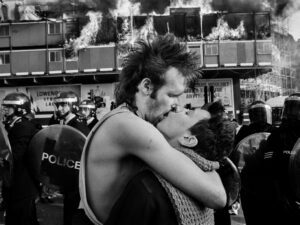In 1967, civil war broke out in Nigeria. The conflict began after two unsuccessful coups, when the Republic of Biafra in the southeast of the country seceded under the leadership of military officer Emeka Odumegwu Ojukwa. Thirty months later, over a million lives had been lost and Biafra officially surrendered. It was under these circumstances that Rotimi Fani-Kayode (1955-1989) grew up. Born twelve years before the beginning of the war, his father was a politician and chieftain of Ife, the ancestral Yoruba capital. As the violence in the country escalated, the family moved to England to seek refuge from the fighting. This autumn, Wexner Centre for the Arts presents a retrospective on the work of Fani-Kayode. The exhibition pays homage to the pioneering artist, tracing the foundations of his work which are rooted in his Nigerian and English identity, his relationship to his parents’ Yoruba culture and the tensions this created with his own sexuality. He once wrote: “on three counts I am an outsider: in matters of sexuality; in terms of geographical and cultural dislocation; and in the sense of not having become the sort of respectably married professional my parents might have hoped for.” This quote arguably encompasses much of Fani-Kayode’s work and life as someone often on the peripheries of societal expectation. It is a roadmap with which we can navigate and understand both artist and art.

To look through the life’s work of Rotimi Fani-Kayode is to see marginalisation in many forms – of Black and queer communities, of the artist himself, but also of cultures, ethnicities and identities in the western perception. In particular, he turns his attention time and again to the fringe status of Yoruba thought in imaginations. The Yorubaland spans the countries of Nigeria, Togo and Benin. The Yoruba people, a West African ethnic group native to the region, constitutes more than 50 million individuals. In their traditional beliefs, the city of Ile Ife is seen as the site of the Earth’s creation – literally translating to “the source of the spreading.” The Kayode family were the keepers of the Shrine of Yoruba Deities and priests of Ife, and there is a sense of spirituality that run throughout Fani-Kayode’s oeuvre. He dissolved the barrier between the mystic and reality, deliberately setting himself apart from the Western cannon. In 1988, he said: “my reality is not the same as that which is often presented to us in Western photography. As an African working in a western medium, I try to bring out the spiritual dimensions in my pictures so that concepts of reality become ambiguous and are open to re-interpretation. This requires what Yoruba priests and artists call a technique of ecstasy.” In his images, the body is posed in rapturous acts of devotion and adorned in traditional African attire, celebrating Yoruba mythology and ancestral past. In one such example, Sonponni (1987), a figure sits facing the camera, head out of shot. Their bare body is covered in colorful spots, grasping three lit candles in their hands. The name of the image is taken from the god of smallpox, a figure that induces fear so great people refuse to speak his name and stalks the countryside in isolation. The photograph, not only mirroring the spots of smallpox and the Yoruba tribal marks, but also sees a symmetry between the artist and the subject – two people who exist as outsiders.

For much of his working life, Fani-Kayode lived and collaborated with his partner Alex Hirst (1951-1992). His photographs are borne out of a tension between his black, African identity and his life as a gay man. He said of his work: “Many of the images are seen as sexually explicit – or more precisely, homosexually explicit. I make my pictures homosexual on purpose. Black men from the Third World have not previously revealed either to their own peoples or to the West a certain shocking fact: they can desire each other.” He treats romantic love with the same spiritual reverence we see elsewhere in his work, challenging the homophobia of Thatcherite England and his home country of Nigeria. This mission takes on even more resonance when we consider how the 1980s was the height of the AIDS crisis. The first cases were reported in 1982, but reports increased rapidly during 1985 and 1985. It is estimated that 90% of people diagnosed during this period were gay and bisexual men, almost all in London. There was no effective treatment to prevent AIDS until 1996, and the year 1994 saw the peak of diagnoses and deaths in the UK, with 1531 people dying of aids and 1851 diagnosed in the UK. Sadly, Rotimi Fani-Kayode was one of those individuals diagnosed during the crisis, and he passed away of a heart attack in 1989 while recovering from an AIDS-related illness. His photographs are unabashedly joyous in their documenting of the male figure and trailblazing in their foregrounding of black queerness and sexual desire. Fani-Kayode may have seen himself as an outsider, but his work does not exist on the edges, instead they are placed right in the heart of contemporary photography and continue to influence new generations of artists.
Rotimi Fani-Kayode: Tranquility of Communion is at Wexner Centre for the Arts until 5 January 2025: wexarts.org
Words: Emma Jacob
Image Credits:
Rotimi Fani-Kayode, Adebiyi, 1989. Courtesy of Autograph, London.





